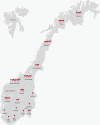Major incident preparedness and on-site work among Norwegian rescue personnel - a cross-sectional study
- PMID: 23134634
- PMCID: PMC3552867
- DOI: 10.1186/1865-1380-5-40
Major incident preparedness and on-site work among Norwegian rescue personnel - a cross-sectional study
Abstract
Background: A major incident has occurred when the number of live casualties, severity, type of incident or location requires extraordinary resources. Major incident management is interdisciplinary and involves triage, treatment and transport of patients. We aimed to investigate experiences within major incident preparedness and management among Norwegian rescue workers.
Methods: A questionnaire was answered by 918 rescue workers across Norway. Questions rated from 1 (doesn't work) to 7 (works excellently) are presented as median and range.
Results: Health-care personnel constituted 34.1% of the participants, firefighters 54.1% and police 11.8%. Training for major incident response scored 5 (1, 7) among health-care workers and 4 (1, 7) among firefighters and police. Preparedness for major incident response scored 5 (1, 7) for all professions. Interdisciplinary cooperation scored 5 (3, 7) among health-care workers and police and 5 (1, 7) among firefighters. Among health-care workers, 77.5% answered that a system for major-incident triage exists; 56.3% had triage equipment available. The majority - 45.1% of health-care workers, 44.7% of firefighters and 60.4% of police - did not know how long it would take to get emergency stretchers to the scene.
Conclusions: Rescue personnel find major incident preparedness and on-scene multidisciplinary cooperation to function well. Some shortcomings are reported with regard to systems for major incident triage, tagging equipment for triage and knowledge about access to emergency stretchers.
Figures
Similar articles
-
Emergency Preparedness and Role Clarity among Rescue Workers during the Terror Attacks in Norway July 22, 2011.PLoS One. 2016 Jun 9;11(6):e0156536. doi: 10.1371/journal.pone.0156536. eCollection 2016. PLoS One. 2016. PMID: 27280520 Free PMC article.
-
Managing multiple-casualty incidents: a rural medical preparedness training assessment.Prehosp Disaster Med. 2013 Aug;28(4):334-41. doi: 10.1017/S1049023X13000423. Epub 2013 Apr 18. Prehosp Disaster Med. 2013. PMID: 23594616
-
Helicopter emergency medical services in major incident management: A national Norwegian cross-sectional survey.PLoS One. 2017 Feb 13;12(2):e0171436. doi: 10.1371/journal.pone.0171436. eCollection 2017. PLoS One. 2017. PMID: 28192440 Free PMC article.
-
[Terrorist attack training exercise-What can be learned? : Baden-Württemberg counterterrorism exercise (BWTEX)].Anaesthesist. 2020 Jul;69(7):477-486. doi: 10.1007/s00101-020-00797-4. Anaesthesist. 2020. PMID: 32488534 Review. German.
-
Medical management of the traumatic consequences of civil unrest incidents: causation, clinical approaches, needs and advanced planning criteria.Toxicol Rev. 2006;25(3):155-97. doi: 10.2165/00139709-200625030-00003. Toxicol Rev. 2006. PMID: 17192122 Review.
Cited by
-
Evaluation of prehospital preparedness for major incidents on a national level, with focus on mass casualty incidents.Eur J Trauma Emerg Surg. 2024 Jun;50(3):945-957. doi: 10.1007/s00068-023-02386-7. Epub 2023 Dec 20. Eur J Trauma Emerg Surg. 2024. PMID: 38117294 Free PMC article.
-
Emergency Preparedness and Role Clarity among Rescue Workers during the Terror Attacks in Norway July 22, 2011.PLoS One. 2016 Jun 9;11(6):e0156536. doi: 10.1371/journal.pone.0156536. eCollection 2016. PLoS One. 2016. PMID: 27280520 Free PMC article.
-
Rapid extrication of entrapped victims in motor vehicle wreckage using a Norwegian chain method - cross-sectional and feasibility study.BMC Emerg Med. 2014 Jul 3;14:14. doi: 10.1186/1471-227X-14-14. BMC Emerg Med. 2014. PMID: 24989364 Free PMC article.
References
-
- Norges Offentlige Utredninger. Søk etter omkomne. Organisering, finansiering og kriterier for søk etter omkomne på havet, i innsjøer og vassdrag, samt på landterritoriet. Oslo: [Norwegian Government Reports: Searching for survivors. Organization, funding and criteria for search operations for survivors in the ocean, in lakes and rivers, as well as on land. In Norwegian] NOU 1999; 1999. p. 6.
-
- Rostrup M, Gilbert M, Stalsberg H. Skreddulykken i Vassdalen [The avalanche disaster in Vassdalen. (In Norwegian)] Tidsskr Nor Legeforen. 1989;109:807–813. - PubMed
LinkOut - more resources
Full Text Sources



